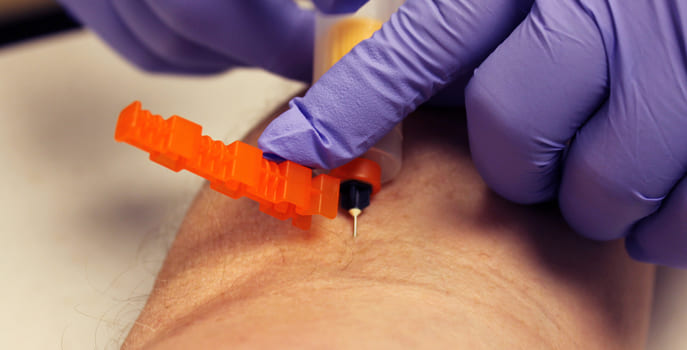A phlebotomist performs a very critical role in healthcare delivery. They are responsible for drawing blood safely and securely from patients for diagnostic procedures, donation, research and transfusions.
The job requires plenty of skill, patience and the ability to calm and comfort worried patients. Nurses and junior doctors are also trained in phlebotomy, but big clinics and hospitals opt for specialists for the job.
With the demand for quality healthcare rising in America the need for qualified phlebotomists is also on the rise. According to the US Bureau of Labor Statistics employment of phlebotomists is set to see a 27% increase from 2012 to 2022. This translates into more than 100,000 new jobs up for grabs.
Phlebotomists are also paid well and the remuneration increases with experience and education.
So if you are interested in carving out a career in this exciting field then read on to find out more.
What Is the Duration of a Phlebotomist Technician Training Program?
A high school diploma, GED or equivalent is all that is required to enroll in a phlebotomist training program. You can also enter the occupation soon after your high school and opt to get trained on the job.
But untrained phlebotomists earn less than their trained and certified counterparts. Also, employers prefer qualified candidates because it means less hours and money spent on training new employees.
Phlebotomists are allied health professionals and can progress and move up the career ladder with experience and continued education.
Medical education is usually very expensive and can stretch into several years. But if you choose the right program you can finish your training in less than one year and start earning on your job right away.
Phlebotomy training programs are available in community colleges, technical schools as well as vocational training institutes. Comprehensive courses incorporate both classroom as well as lab instruction.
Clinical and lab experience are essential to give students first-hand knowledge of their job.
The phlebotomy technician training program we offer includes theoretical and clinical training. Successful students can take the Certified Phlebotomy Certification exam.
What Are the Necessary Skills a Phlebotomist Should Have?
Your program you will help develop several skills that are essential to perform your role as a phlebotomist to perfection.
The art of drawing blood from veins is called venipuncture. During the course of your study you will gain good knowledge about the human anatomy and medical terminology, and learn to identify correct veins and use proper blood collection techniques.
Phlebotomists will be required to draw blood from patients suffering from infectious and serious illnesses. In such cases safety should be of foremost priority to you. An accidental prick from a used needle will result in spreading blood-borne diseases and contaminants.
You will also be trained in the latest and the best collection procedures, storage techniques and transportation guidelines. This is because, very often, the collected blood and other specimen samples will have to be transported to pathological labs or test centers at offsite locations.
Any mix-up or contamination of the specimen samples will give wrong test results, which in turn can lead to wrong diagnosis and faulty treatment.
In your training program you will be taught to collect specimen samples in appropriate tubes and vials containing suitable additives. They have to be sealed and labeled accurately, stored safely and transported carefully. Quality, safety and hygiene are of utmost importance in your job.
Phlebotomists will also have to record and document all patient details and corresponding tests for billing, and insurance-related purposes.
Technical Aspects of the Job Are Also Important
A phlebotomy technician training program will teach you to operate and maintain the clinical and lab equipment. You will also learn to use protective gear like gloves and masks, especially while dealing with infectious and dangerous samples.
A phlebotomist is also responsible for the safe disposal of medical waste including used syringes and tubes.
Brush up Your Communication Skills
An important part of a phlebotomist’s job is to calm, pacify and educate worried patients.
Many patients are scared of getting ‘pricked’ by a needle and find the act of drawing blood unnerving. You will have to calm down the patient and extract blood as carefully as possible. If you manage to keep the subject occupied or engrossed in a conversation, then you will be able to finish the procedure without further trouble.
Children and elderly are the most demanding of the subjects. You will need to be tactful and extremely careful with children, because a screaming 6-year-old will not be very co-operative.
When it comes to aged patients you will have difficulty in locating the appropriate veins. With experience, you will gain the necessary skill and ability to perform difficult procedures.
Job Outlook
Medical profession as a whole is set to witness a huge increase in the demand for new professionals. The baby boomer population in our country is aging and there is a growing need for quality healthcare and related services. Lifestyle diseases like diabetes and hypertension are becoming more common, and the healthcare industry needs to cater to them as well.
Infectious and fast-spreading diseases which were once seen only in backward countries are making their presence felt on our shores as well. The medical fraternity needs to brace itself to take care of any unforeseen eventuality.
R&D investments in healthcare have doubled and the need for clinical support workers is predicted to increase drastically.
So this is the right time to consider a career in the healthcare and allied services.
Certification and Licensing Requirements
Our phlebotomist technician training program is of 80-hour duration. You can seek employment and start working right after successfully completing the course.
Certification is not mandatory but many employers prefer to hire certified professionals. On graduating from an accredited training program you can opt to take any of the recognized certification exams.
American Society for Clinical Pathology, National Phlebotomy Association and the American Medical Technologists offer certification to trained phlebotomists.
Thus you can see that training and certification will not take more than a few months of your time and will help you compete with the best in the talent pool for your dream job.
Conclusion
A phlebotomist has a fast-growth career ahead of him or her. Join the best training school and make sure you start your career on the right note.




